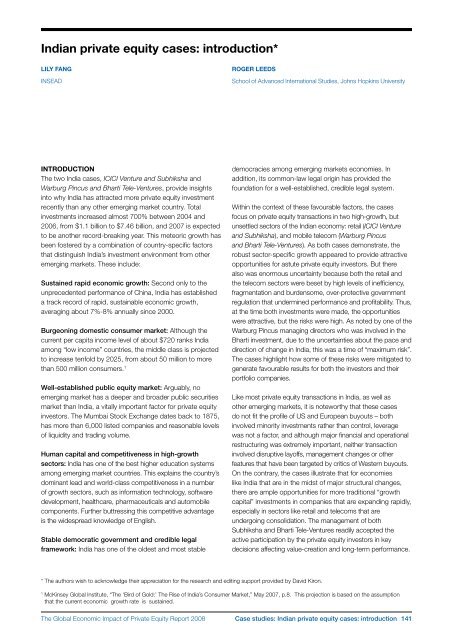The Global Economic Impact of Private Equity Report 2008 - World ...
The Global Economic Impact of Private Equity Report 2008 - World ...
The Global Economic Impact of Private Equity Report 2008 - World ...
- No tags were found...
Create successful ePaper yourself
Turn your PDF publications into a flip-book with our unique Google optimized e-Paper software.
Indian private equity cases: introduction*lily FanginseadRoger LeedsSchool <strong>of</strong> Advanced International Studies, Johns Hopkins UniversityIntroduction<strong>The</strong> two India cases, ICICI Venture and Subhiksha andWarburg Pincus and Bharti Tele-Ventures, provide insightsinto why India has attracted more private equity investmentrecently than any other emerging market country. Totalinvestments increased almost 700% between 2004 and2006, from $1.1 billion to $7.46 billion, and 2007 is expectedto be another record-breaking year. This meteoric growth hasbeen fostered by a combination <strong>of</strong> country-specific factorsthat distinguish India’s investment environment from otheremerging markets. <strong>The</strong>se include:Sustained rapid economic growth: Second only to theunprecedented performance <strong>of</strong> China, India has establisheda track record <strong>of</strong> rapid, sustainable economic growth,averaging about 7%-8% annually since 2000.Burgeoning domestic consumer market: Although thecurrent per capita income level <strong>of</strong> about $720 ranks Indiaamong “low income” countries, the middle class is projectedto increase tenfold by 2025, from about 50 million to morethan 500 million consumers. 1Well-established public equity market: Arguably, noemerging market has a deeper and broader public securitiesmarket than India, a vitally important factor for private equityinvestors. <strong>The</strong> Mumbai Stock Exchange dates back to 1875,has more than 6,000 listed companies and reasonable levels<strong>of</strong> liquidity and trading volume.Human capital and competitiveness in high-growthsectors: India has one <strong>of</strong> the best higher education systemsamong emerging market countries. This explains the country’sdominant lead and world-class competitiveness in a number<strong>of</strong> growth sectors, such as information technology, s<strong>of</strong>twaredevelopment, healthcare, pharmaceuticals and automobilecomponents. Further buttressing this competitive advantageis the widespread knowledge <strong>of</strong> English.Stable democratic government and credible legalframework: India has one <strong>of</strong> the oldest and most stabledemocracies among emerging markets economies. Inaddition, its common-law legal origin has provided thefoundation for a well-established, credible legal system.Within the context <strong>of</strong> these favourable factors, the casesfocus on private equity transactions in two high-growth, butunsettled sectors <strong>of</strong> the Indian economy: retail (ICICI Ventureand Subhiksha), and mobile telecom (Warburg Pincusand Bharti Tele-Ventures). As both cases demonstrate, therobust sector-specific growth appeared to provide attractiveopportunities for astute private equity investors. But therealso was enormous uncertainty because both the retail andthe telecom sectors were beset by high levels <strong>of</strong> inefficiency,fragmentation and burdensome, over-protective governmentregulation that undermined performance and pr<strong>of</strong>itability. Thus,at the time both investments were made, the opportunitieswere attractive, but the risks were high. As noted by one <strong>of</strong> theWarburg Pincus managing directors who was involved in theBharti investment, due to the uncertainties about the pace anddirection <strong>of</strong> change in India, this was a time <strong>of</strong> “maximum risk”.<strong>The</strong> cases highlight how some <strong>of</strong> these risks were mitigated togenerate favourable results for both the investors and theirportfolio companies.Like most private equity transactions in India, as well asother emerging markets, it is noteworthy that these casesdo not fit the pr<strong>of</strong>ile <strong>of</strong> US and European buyouts – bothinvolved minority investments rather than control, leveragewas not a factor, and although major financial and operationalrestructuring was extremely important, neither transactioninvolved disruptive lay<strong>of</strong>fs, management changes or otherfeatures that have been targeted by critics <strong>of</strong> Western buyouts.On the contrary, the cases illustrate that for economieslike India that are in the midst <strong>of</strong> major structural changes,there are ample opportunities for more traditional “growthcapital” investments in companies that are expanding rapidly,especially in sectors like retail and telecoms that areundergoing consolidation. <strong>The</strong> management <strong>of</strong> bothSubhiksha and Bharti Tele-Ventures readily accepted theactive participation by the private equity investors in keydecisions affecting value-creation and long-term performance.* <strong>The</strong> authors wish to acknowledge their appreciation for the research and editing support provided by David Kiron.1McKinsey <strong>Global</strong> Institute, “<strong>The</strong> ‘Bird <strong>of</strong> Gold:’ <strong>The</strong> Rise <strong>of</strong> India’s Consumer Market,” May 2007, p.8. This projection is based on the assumptionthat the current economic growth rate is sustained.<strong>The</strong> <strong>Global</strong> <strong>Economic</strong> <strong>Impact</strong> <strong>of</strong> <strong>Private</strong> <strong>Equity</strong> <strong>Report</strong> <strong>2008</strong> Case studies: Indian private equity cases: introduction 141















